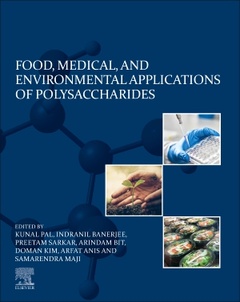Food, Medical, and Environmental Applications of Polysaccharides
Coordonnateurs : Pal Kunal, Banerjee Indranil, Sarkar Preetam, Bit Arindam, Kim Doman, Anis Arfat, Maji Samarendra

Food, Medical, and Environmental Applications of Polysaccharides provides a detailed resource for those interested in the design and preparation of polysaccharides for state-of-the-art applications. The book begins with an introductory section covering sources, chemistry, architectures, bioactivity, and chemical modifications of polysaccharides. Subsequent parts of the book are organized by field, with chapters focusing on specific applications across food, medicine, and the environment. This is an extremely valuable book for researchers, scientists, and advanced students in biopolymers, polymer science, polymer chemistry, biomaterials, materials science, biotechnology, biomedical engineering, cosmetics, medicine, food science, and environmental science.
This important class of biopolymer can offer attractive properties and modification potential, enabling its use in groundbreaking areas across food, medical, and environmental fields. The book will be of interest to scientists, R&D professionals, designers, and engineers who utilize polysaccharide-based materials.
Part I: Introduction1. Introduction to polysaccharides2. Bioactivity of the polysaccharides3. Chemical modifications of polysaccharides
Part II: Food applications4. Protein separation and purification5. Edible films6. Oil entrapped films7. Gels8. Nanocomposites9. Nutraceutical delivery systems
Part III: Medical applications10. Tissue engineering11. Anticoagulation12. Drug delivery systems13. Antitumor activity of polysaccharides14. Polysaccharides for osteoarthritis therapy15. Polysaccharides for ocular disorder therapy16. Environment-responsive polysaccharides17. Antimicrobial polysaccharides18. Immobilization of probiotics19. Immobilization of enzymes20. Wound dressings21. Biosensors
Part IV: Environmental applications22. Marine applications23. Electrochemical biosensors24. Immobilization of microbial cells25. Effluent treatment using polysaccharides26. Biodiesel production27. Reinforcing agents in green composites28. Environment-responsive polysaccharides
Academic: Researchers, scientists and advanced students in biopolymers, polymer science, polymer chemistry, biomaterials, materials science, biotechnology, biomedical engineering, cosmetics, medicine, food science, and environmental science.
Industry: Scientists, R&D professionals, designers and engineers across industries and disciplines, looking to utilize polysaccharide-based materials.
Prof. Indranil Banerjee did his Ph. D. in Biotechnology (Tissue Engineering) from Indian Institute of Technology Kharagpur, India in the year 2011. Presently, is holding the position of an Assistant Professor in the Department of Biotechnology and Medical Engineering at National Institute of Technology- Rourkela. He is the Professor-in-Charge of the Bioprocess Laboratory and Biomicrofludics Laboratory. His group is actively involved in understanding the cell physiology in response to biomaterials developed on a length scale (nano to macro). He was a visiting scientist in Maxplanck Institute of Intelligent System, Germany. Dr. Banerjee has authored 35 SCI cited publications in various journals of repute with a total citation of more than 450. He is also serving as industrial consultant.
Dr. Preetam Sarkar is an Assistant Professor of Food Sciences at the Department of Food Process Engineering, National Institute of Technology Rourkela, Odisha, India. He completed his Ph.D. in Food Sciences from Purdue University, USA. The research at Dr. Sarkar’s lab at NIT Rourkela focuses on the development of delivery vehicles such as emulsions, films and coatings, for the protection of bioactive compounds such as antimicrobial agents for food safety applications. He has published 30 articles in SCI journals, 10 book chapters, and co-edited 3 books.
He received his PhD in Biofluidic Engineering at Jadavpur University, India in 2016. Currently, he is working as an Assistant Professor in the Department of Biomedical Engineering, National Instit
- Presents comprehensive information of the polymeric structures and properties that can be developed from polysaccharides
- Offers systematic coverage of classification, synthesis, and characterization, enabling targeted design and preparation of polysaccharides for specific applications
- Explores advanced methods, for novel applications across food, medicine, and the environment
Date de parution : 12-2020
Ouvrage de 756 p.
19x23.3 cm
Thèmes de Food, Medical, and Environmental Applications of... :
Mots-clés :
?Active compounds; Adsorption; Advanced oxidation processes; Alginate; Antibacterial; Anticorrosion; Antifouling; Antimicrobial susceptibility testing; Antimicrobials; Antioxidants; Applications; BREs; Bacterial infections; Bentonite; Bioactive; Bioavailability; Biodiesel; Biofilms; Biomedical applications; Biopolymers; Biosensor; Carbohydrates; Catalytic degradation; Cellulose; Chitosan; Ciprofloxacin HCl; Classification; Colorimetric detection; Cyclodextrin; Drug release; Edible films; Edible oils; Effluent treatment; Electrochemical biosensor; Electrode; Electrophile; Emulsions; Encapsulation; Environments; Enzyme; Feasibility of AOPs; Fenton; Fenton-like; Films; Foams; Food; Food safety; Formulations; Fortification; Fucoidan; Functionality; Gelatin; Gellan gum; Gels; Generations of biodiesel; Health benefits; Heavy metals; Hemoglobin; Hollow channels; Hydrogels; Industrial; Lipids; Liver; Macroporous scaffolds; Matrices; Medicinal; Micro- or nanoparticles; Microfluidics; Nanoemulsions; Nanoencapsulation; Nanoliposomes; Nanotechnology; Natural polysaccharides; Natural sources; Nonbiodegradability; Nucleophile; Nutraceuticals; Ocular drug delivery; Oils; Paper-based devices; Phase-separated; Physical hydrogels; Pollutants; Polysaccharide; Polysaccharides; Properties; Proteins; Remediation; Renewable energy; Rice starch; Self-assembled monolayers; Semiconductor; Shelf-life stability; Starch; Surface plasmon resonance; Tamarind gum; Tissue engineering; Transesterification; Viscosity; Wastewater



